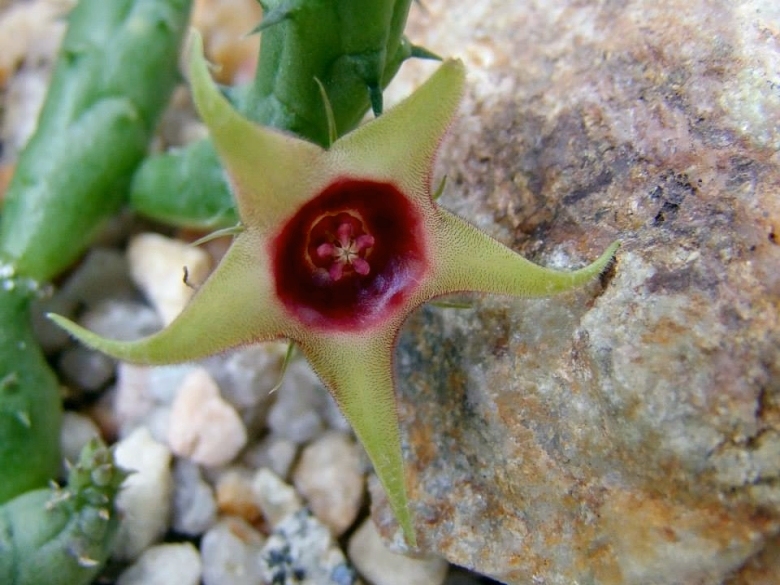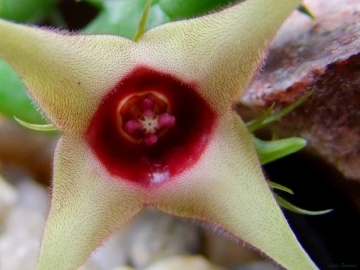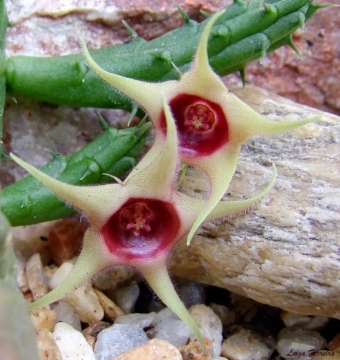Accepted Scientific Name: Huernia verekeri subs. angolensis (L.C.Leach) Bruyns
Stapeliads S. Africa Madagascar 1: 139. 2005 Bruyns

Huernia verekeri var. angolensis (Huernia verekeri subs. angolensis) Photo by: Luiza Ferreira
Origin and Habitat: Huíla district, Angola.
Type locality: Angola, Huíla, On cliffs above Bruco, on the western escarpement of the Serra da Chela to the west of Tchivinguiro.
Synonyms:
See all synonyms of Huernia verekeri
Description: Huernia verekeriSN|29683]]SN|29683]] subsp. Angolensis differs from the typical Huernia verekeriSN|29683]]SN|29683]] for the stems that are bent outwards and downwards, these bluntly ribbed with small tubercles. The corolla tube is wholly dark red inside and the corona is reddish.
Subspecies, varieties, forms and cultivars of plants belonging to the Huernia verekeri group
 Huernia verekeri Stent: has erect stems with narrow soft teeth. Flowers numerous star-like pale pinkish about 35 mm in diameter, the tube white at the base. Distribution: Zambia, Zimbabwe, Malawi, Mocambique, Botswana, Namibia.
Huernia verekeri Stent: has erect stems with narrow soft teeth. Flowers numerous star-like pale pinkish about 35 mm in diameter, the tube white at the base. Distribution: Zambia, Zimbabwe, Malawi, Mocambique, Botswana, Namibia. Huernia verekeri subs. angolensis (L.C.Leach) Bruyns: has deflexed stems lacking the strongly toothed angles of the typical variety and the corolla tube is bright red inside. Corona reddish. Distribution: Huila district in Angola.
Huernia verekeri subs. angolensis (L.C.Leach) Bruyns: has deflexed stems lacking the strongly toothed angles of the typical variety and the corolla tube is bright red inside. Corona reddish. Distribution: Huila district in Angola. - Huernia verekeri subs. pauciflora (L.C.Leach) Bruyns: has much longer, prostrate stems with blunt angles and widely spaced smaller teeth. Inflorescence one- or few-flowered at the base of the new branches. Distribution: mouth of the Save River in Mozambique.
Bibliography: Major references and further lectures
1) Focke Albers, Ulrich Meve “Illustrated Handbook of Succulent Plants: Asclepiadaceae: Asclepiadaceae” Volume 4 Springer Science & Business Media, 2002
2) Court, D. “Succulent flora of southern Africa” revised edn. Balkema, Rotterdam. 2000.
3) J. S. African Bot. 40: Fig. 3 (1974)
4) Excelsa Taxon. Ser. 4: 145-149 (1988)
 Huernia verekeri var. angolensis (Huernia verekeri subs. angolensis) Photo by: Luiza Ferreira
Huernia verekeri var. angolensis (Huernia verekeri subs. angolensis) Photo by: Luiza Ferreira Huernia verekeri var. angolensis (Huernia verekeri subs. angolensis) Photo by: Luiza Ferreira
Huernia verekeri var. angolensis (Huernia verekeri subs. angolensis) Photo by: Luiza FerreiraCultivation and Propagation: Spring: When winter ends and they begin to grow again, they will require much water and soaking the pots will no longer put the plants at risk for rot. In the spring they will grow well in partial shade and leaving them out in the rain may provide them with the water they need.
Summer: In the summer months they will tolerate heavy rain, but will be just as happy if the season is dry. It's best to sort out the stems while the plants are resting in the summer before they begin their autumnal growth cycle. They will tolerate very hot weather outdoors as long as they are kept in filtered light and this will encourage them to flower in the Autumn. They also enjoy some fertiliser. Moving the plants as they are developing buds may cause them to spontaneously abort the flowers all together.
Autumn: In the fall keep them outdoors until the night time temperatures drop below the 5°C.
Winter: Winter care presents no problems at 5°-10° C with plenty of light. As soon as they are flowered be sure to take extra precautions to keep them dry, because damp cool conditions when the plants are resting is an invitation to fungal infections, but - according to temperatures –some occasional lit watering may be useful.
Potting medium: Since roots are quite shallow, use a cactus mix or add extra perlite or pumice to regular soil potting soil. A gritty, very free-draining compost is suitable, and clay pots help the plants to dry out between watering. Re-pot every 2 years.
Pest and diseases: Huernia are generally fairly easy to grow, especially if kept pest-free. They are very susceptible to stem and root mealy bugs, and damage from these may well initiate fungal attack. Any time when there is a dead or dying stem in the pot it is important to remove it immediately and completely before other healthy stems can become ill too, isolate the healthy parts, dry them off, and re-root them in new compost.
Propagation: Easiest with stem cuttings. Allow cuttings to dry a day before planting. Stems must be laid (Not buried) on gritty compost and will then root from the underside of the stems. It can also be increased from seeds sowing in spring in moist, sandy peat moss. Barely cover seeds. Seeds germinate quickly.
In any season it's best to lay the stems out for several days before replanting them and then pot them only in dry soil and withhold any water until they begin to shrivel or start growing again.












